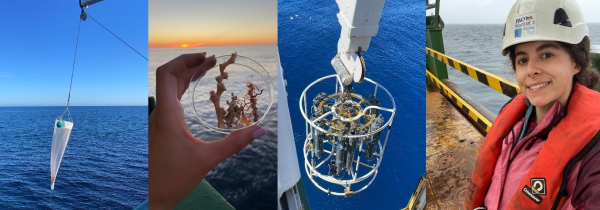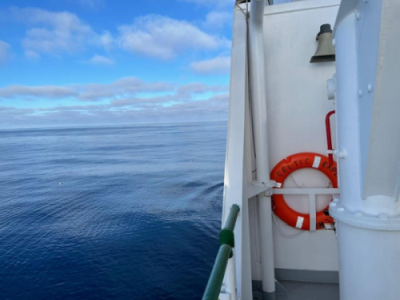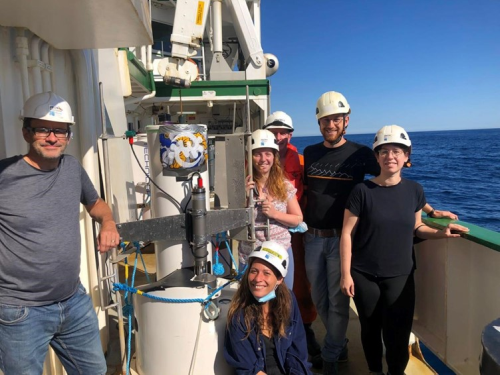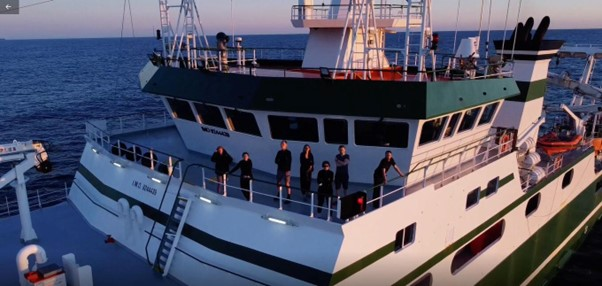iCRAG Co-PI Prof. Andy Wheeler and crew recently returned from a research cruise at sea. Below are the accompanying blog posts.
Worse things can happen at sea…
By Prof. Andy Wheeler
Or so the saying goes, not sure if its true nowadays but certainly the sea can be unforgiving. Stormy seas have hampered may a well planned marine survey and technical failures can be common due to the corrosive nature of the sea and the constant motion of the ship (putting electronic equipment into seawater and pressurising it at depth is asking for trouble – right?).
I am Professor Andy Wheeler, the chief scientist on the CE22013 SPeeD survey (Sediment Plume Sampling, Bedrock Drilling and Coral Surveying) on the RV Celtic Explorer and I’d like to tell you what we managed to do despite the odds.
We had ambitious plans for this survey:
- To continue environmental studies of cold-water coral habitats in the Belgica Mound SAC,
- To detect, track and sample sediment plumes created through seabed trawling down the Whittard Canyon,
- and to rockdrill bedrock exposure in Whittard, Goban Spur and Porcupine Bank to simply see what rock formations are there (we have no idea of the geology of the southern Irish margins!).
However, despite stringent and meticulous behaviour and measures involving numerous pre-boarding PCR and antigen tests COVID unavoidably managed, inevitably these days, to get on-board. We immediately isolated and retired to port cancelling most of our survey as we responsibly got the virus under control.
However, we’re tenacious and before and after isolation we managed to complete our Belgica SAC objectives involving:
- the recovery of 2 Little MonSta benthic landers (Beyonce and President Higgins) after 1 year monitoring currents next to a Moira Mound cold-water coral reefs,
- the deployment of 2 more Little MonStas (Apollo and Charlotte) in a ridged coral reef measuring currents, water turbidity, dissolved oxygen, pH, temperature and salinity as well as monitoring and sampling sediments,
- the collection of coral samples from 5 sites (on Therese and Little Therese Mounds) and plankton samples from 3 (offshore Cork, Galway and the Belgica Mounds) to check for microplastics,
- the mapping of 256 km2 of the Belgica Mounds (including the Moira Mounds) with a shipbased multibeam echosounder,
- and, the collection of water samples (for sediment concentrations and microplastics) at the seabed, mid-water and near the surface at 5 sites.
So I would say even against the odds, good things can happen at sea.

Charlotte Little MonSta on a coral ridge in the Belgica Mounds SAC at 912m water depth
Two more blogs will follow this one, firstly by Dr Alicia Mateos Cardenas on her microplastic work and finally by Jess Harty on her first experiences of going to sea on this dramatic survey – say tuned!
The cruise report is available here: https://www.ucc.ie/en/media/research/marinegeo/mgpdfs/SPeeDCruiseReportFInal.pdf.
--
Sampling for microplastics off the west coast of Ireland
Dr Alicia Mateos Cardenas
I am Dr Alicia Mateos Cardenas, a postdoc working in the UCC Marine Geosciences team on a Marine Institute funded project on microplastics. I am very interested in understanding the anthropogenic impacts of pollution in the environment. So, as part of my postdoc, I am investigating the presence of microplastics in marine Special Areas of Conservation (SACs) which are also key habitats for cold water corals. The preliminary results from a previous survey actually indicate that litter and microplastics are present in our areas of study, unfortunately.

From left to right: plankton net used to sample surface waters, some corals in a petri dish and the sunset, CTD coming back from 950 meters deep with water column samples and Alicia all geared up on deck for sampling
I was delighted to be able to join this year’s research cruise (SPeeD: CE22013) on the RV Celtic Explorer for the first time and to be in charge of the work related to microplastic sampling! I was very lucky to be able to collect several samples for my studies in a short amount of time and enjoy stunning sunsets.
In total, we collected surface water samples using a plankton net, water column samples using a CTD rosette and a diverse amount of cold-water coral species. I am now very excited to be back in the lab and have a look at all these new water and coral samples collected from 0 to 950 meters deep! Do cold-water coral ingest microplastics, we will see.
--
Corals, fin whales, calm seas and some serious science…
By Jess Harty
We’ve just disembarked in Galway after an eventful survey where we managed to collect some valuable data and memories to last for ever. For my first time on a research vessel with state-of-the-art equipment and highly professional scientists and crew, I am walking away with an experience of a lifetime with inspiration and motivation for a future studying the unexplored depths of our Earth.

Perfect surveying weather, it doesn’t get better than this out on the high seas
During our time at sea, we successfully retrieved two multi-sensor landers (Little MonStas) from the ocean floor named after our very own president President Higgins and an icon of this era, Beyonce. Both landers hosted ADCPs which give us unique insight into the deep ocean floor environment, 1000m deep. Following retrieval of President Higgins and Beyonce we replaced them with two more landers named after legends of equal importance; Apollo who needs no introduction and Charlotte named in memory of Charlotte Appah, a colleague’s mother, who tragically passed away to COVID last year. We attached the Ghanaian symbol of Gye Nyame (God), a symbol of importance for the Appah family, to the lander. Charlotte’s deployment was a very special and emotional deployment for the scientists on board.

Apollo and Charlotte are fitted with new sensors made specifically for this survey. These sensors will provide us with even more information of the seabed environment to allow elaboration and further insight into the processes occurring at such depths. When these landers are retrieved next year a wealth of information will allow us not only to understand our oceans better but also how to protect these unique environments from effects of climate change. This deployment should provide conductivity, temperature, density, dissolved oxygen, pH, turbidity, and sediment flow data.
Another successful mission included collecting plankton and coral samples to identify the level of pollutants absorbed. Microplastic analysis of the water column can be carried out when we return to shore from the collected samples. Alicia our Environmental Scientist is focusing her postdoc on this area as explained in the previous blog.
What a wonderful experience and I hope to come back next year to collect the landers and see what they discovered…




